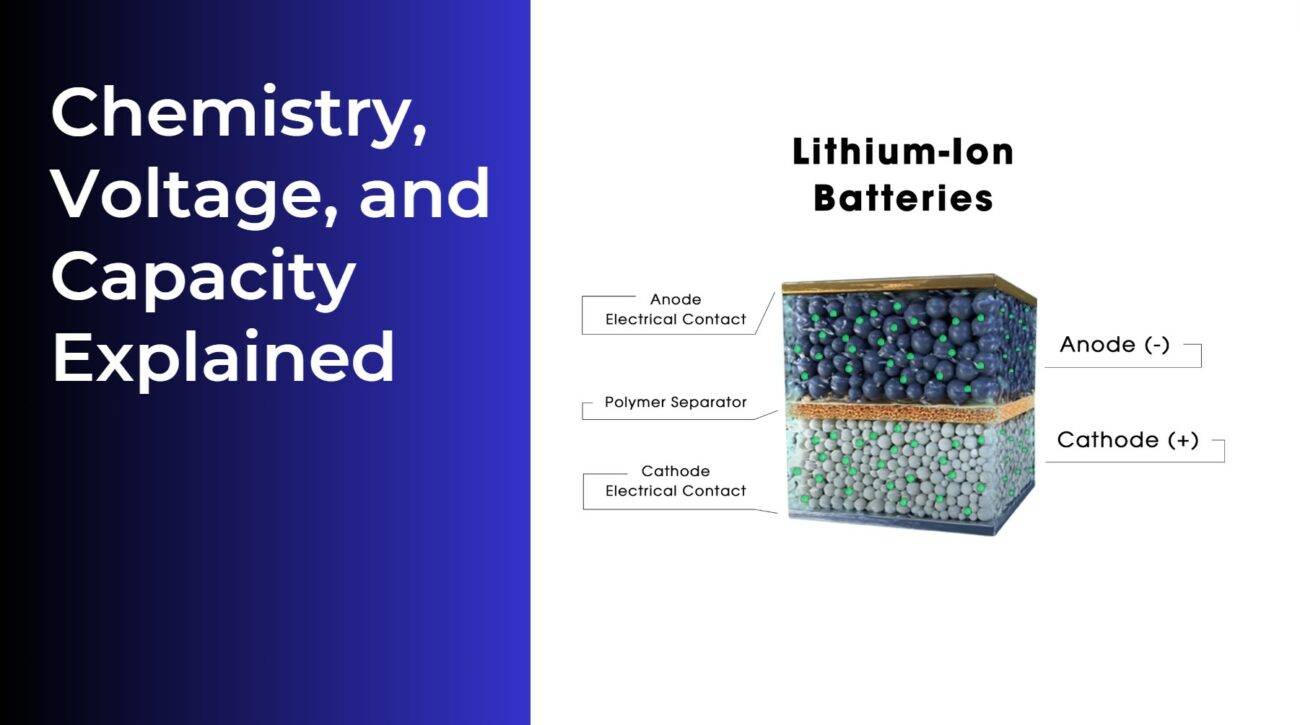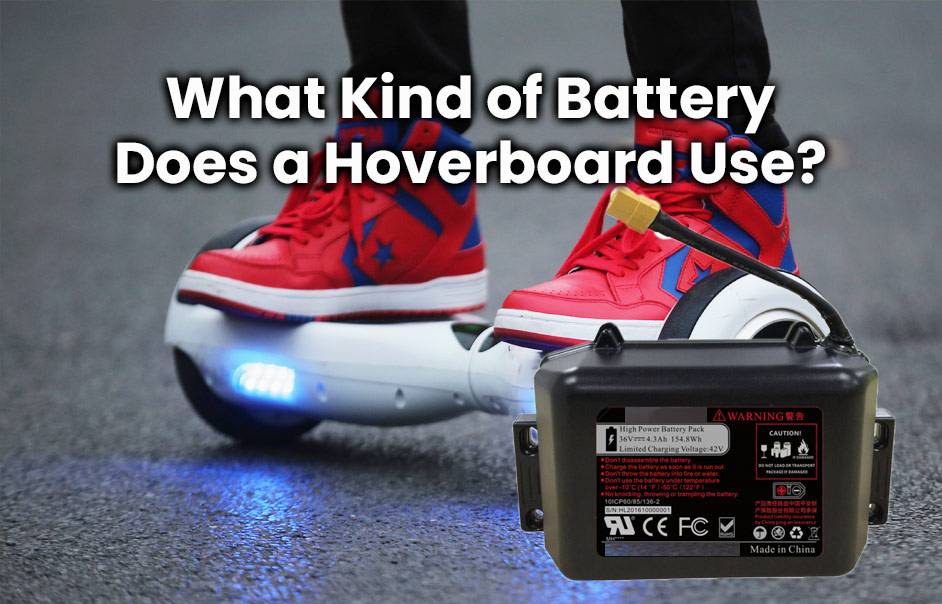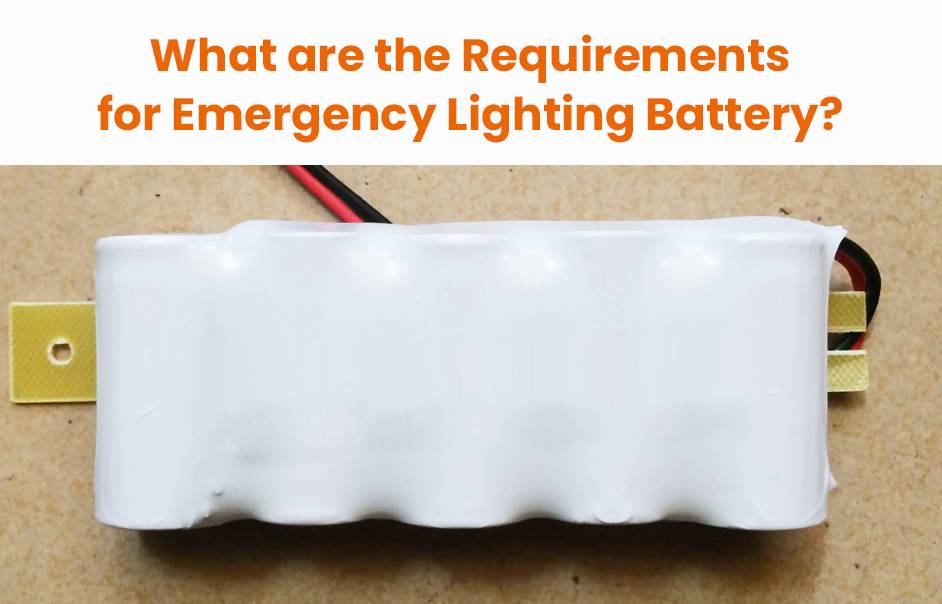- Lithium Golf Cart Battery
- Forklift Lithium Battery
-
48V
- 48V 210Ah
- 48V 300Ah
- 48V 420Ah (949 x 349 x 569 mm)
- 48V 420Ah (950 x 421 x 450 mm)
- 48V 456Ah
- 48V 460Ah (830 x 630 x 590 mm)
- 48V 460Ah (950 x 421 x 450 mm)
- 48V 460Ah (800 x 630 x 600 mm)
- 48V 460Ah (820 x 660 x 470 mm)
- 48V 500Ah
- 48V 560Ah (810 x 630 x 600 mm)
- 48V 560Ah (950 x 592 x 450 mm)
- 48V 600Ah
- 48V 630Ah
-
48V
- 12V Lithium Battery
12V 150Ah Lithium RV Battery
Bluetooth App | BCI Group 31
LiFePO4 Lithium
Discharge Temperature -20°C ~ 65°C
Fast Charger 14.6V 50A
Solar MPPT Charging - 24V Lithium Battery
- 36V Lithium Battery
- 48V Lithium Battery
-
48V LiFePO4 Battery
- 48V 50Ah
- 48V 50Ah (for Golf Carts)
- 48V 60Ah (8D)
- 48V 100Ah (8D)
- 48V 100Ah
- 48V 100Ah (Discharge 100A for Golf Carts)
- 48V 100Ah (Discharge 150A for Golf Carts)
- 48V 100Ah (Discharge 200A for Golf Carts)
- 48V 150Ah (for Golf Carts)
- 48V 160Ah (Discharge 100A for Golf Carts)
- 48V 160Ah (Discharge 160A for Golf Carts)
-
48V LiFePO4 Battery
- 60V Lithium Battery
-
60V LiFePO4 Battery
- 60V 20Ah
- 60V 30Ah
- 60V 50Ah
- 60V 50Ah (Small Size / Side Terminal)
- 60V 100Ah (for Electric Motocycle, Electric Scooter, LSV, AGV)
- 60V 100Ah (for Forklift, AGV, Electric Scooter, Sweeper)
- 60V 150Ah (E-Motocycle / E-Scooter / E-Tricycle / Tour LSV)
- 60V 200Ah (for Forklift, AGV, Electric Scooter, Sweeper)
-
60V LiFePO4 Battery
- 72V~96V Lithium Battery
- Rack-mounted Lithium Battery
- E-Bike Battery
- All-in-One Home-ESS
- Wall-mount Battery ESS
-
Home-ESS Lithium Battery PowerWall
- 24V 100Ah 2.4kWh PW24100-S PowerWall
- 48V 50Ah 2.4kWh PW4850-S PowerWall
- 48V 50Ah 2.56kWh PW5150-S PowerWall
- 48V 100Ah 5.12kWh PW51100-F PowerWall (IP65)
- 48V 100Ah 5.12kWh PW51100-S PowerWall
- 48V 100Ah 5.12kWh PW51100-H PowerWall
- 48V 200Ah 10kWh PW51200-H PowerWall
- 48V 300Ah 15kWh PW51300-H PowerWall
PowerWall 51.2V 100Ah LiFePO4 Lithium Battery
Highly popular in Asia and Eastern Europe.
CE Certification | Home-ESS -
Home-ESS Lithium Battery PowerWall
- Portable Power Stations
21700 vs 18650 Battery Comparison in Details

18650 cells are among the most popular rechargeable lithium-ion batteries due to their widespread availability and reasonable pricing. While they provide distinct advantages, they may be slightly more expensive than the larger 21700 lithium batteries.
What is 21700 battery?
A “21700 battery” is a rechargeable lithium-ion battery with dimensions of 21mm in diameter and 70mm in length. Initially popularized in electric cars like Tesla and electric scooters, these batteries are now commonly used in vaping devices and flashlights.
What is the advantages of 21700 cells?
21700 cells offer significant advantages for various applications, making them a popular choice in the world of lithium-ion batteries:

- Higher Capacity: These cells boast a larger capacity, providing devices with more extended and efficient power.
- Higher Discharge Rate: With a higher discharge rate, 21700 cells can deliver power more quickly, catering to devices requiring bursts of energy or high power output.
- Improved Energy Density: The enhanced energy density allows these cells to store more energy in a given volume, making them ideal for applications where space is a premium.
- Better Thermal Performance: 21700 cells exhibit improved thermal performance, handling heat more effectively during charging and discharging, contributing to overall safety and longevity.
- Versatile Applications: Thanks to their combination of high capacity, discharge rate, and energy density, 21700 cells find use in various devices, including electric vehicles, flashlights, and high-performance electronics.
- Tesla Usage: The adoption of 21700 cells by Tesla, particularly in the Model 3, underscores their advantages in terms of energy efficiency and performance.
It’s important to consider that specific advantages may vary between different brands and models of 21700 cells, with factors like application and battery chemistry influencing their performance. Choosing the right 21700 cell depends on these factors for optimal results.
How many types of 21700 cells are available in the market?
The market presents a range of 21700 cells, featuring diverse types and specifications. Prominent manufacturers like Samsung, LG, Panasonic/Sanyo, and Tesla produce multiple models tailored for various applications. Each brand and model may exhibit unique characteristics, including capacity and discharge rate, catering to different uses. Redway 21700 battery cells are now available, providing further options for consumers.
What is 18650 Battery?
An “18650 battery” is a rechargeable lithium-ion battery measuring 18mm in diameter and 65mm in length. Known for their impressive capacity and rapid power delivery, these batteries are commonly utilized in flashlights, laptops, scooters, and other high-energy-demand devices.
Notably, even Tesla Model S cars utilize 18650 cells, underscoring their versatility. Initially gaining prominence in electric cars and scooters, especially in Tesla vehicles.
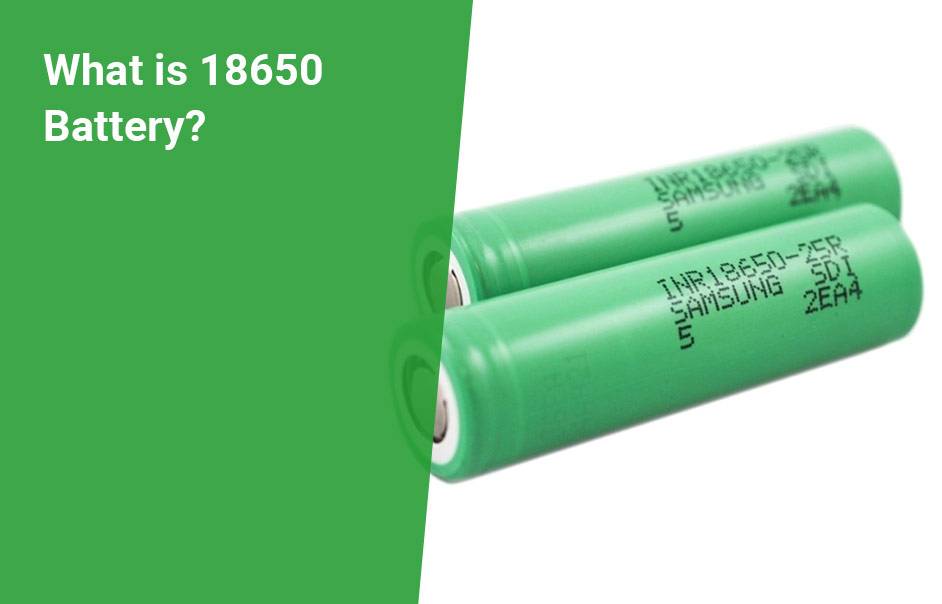
How many types of 18650 battery cells are available in the market?
There are numerous types and models of 18650 cells available in the market, produced by various manufacturers. the lifespan of most NCM 18650 cells are roughly 300-1000 times. Different brands offer 18650 cells with varying specifications, capacities, discharge rates, and chemistries to meet the diverse needs of applications such as laptops, flashlights, vaping devices, and electric vehicles.
21700 vs 18650 lithium battery in details
When comparing 21700 and 18650 lithium-ion batteries, it’s essential to consider factors like size, chemistry, voltage, charging, discharging, applications, capacity, and advantages.
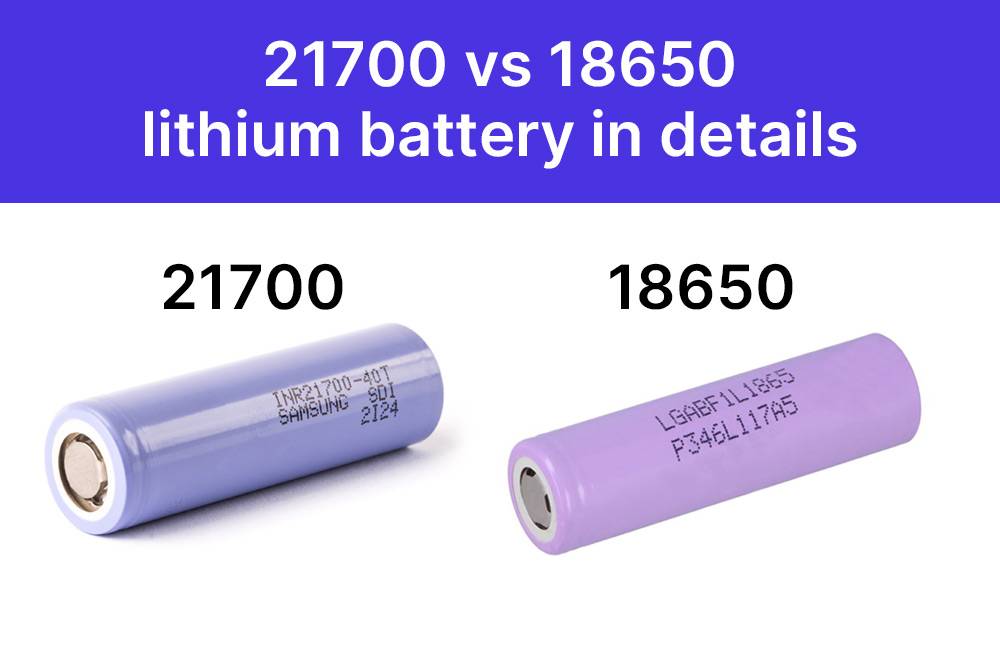
- Size:
- 21700 is larger at 21mm x 70mm, while 18650 is smaller at 18mm x 65mm.
- Chemistry:
- Both batteries utilize lithium-ion technology for power.
- Voltage:
- They operate at approximately 3.6 – 3.7 volts.
- Charging:
- Both can be charged with a standard lithium-ion battery charger.
- Discharging:
- Both provide quick power for various devices.
- Applications:
- They power devices such as laptops, flashlights, and electric vehicles.
- Capacity:
- 21700 stores more energy than 18650.
- Advantages:
- 21700 is suitable for high-powered devices, while 18650 has less capacity and is not ideal for high-powered gadgets.
To illustrate the variance in power and capacity between 21700 and 18650 lithium batteries, we conducted tests using the Fenix HT18 hunting flashlight, boasting 1500 lumens. This flashlight seamlessly accommodates both battery types with an insert. The disparities in performance are evident in the light modes:
With a 21700 Li-Ion battery:

- Turbo mode emits 1500 lumens, lasting approximately 1 hour and 40 minutes.
- High mode offers 500 lumens, with a runtime of around 4 hours and 15 minutes.
- Medium mode delivers 150 lumens for approximately 20 hours and 15 minutes.
- Low mode provides 30 lumens, enduring for 61 hours.
- Strobe mode emits 1500 lumens.
When powered by an 18650 Li-Ion battery:
- Turbo mode outputs 1100 lumens, lasting roughly 1 hour and 40 minutes.
- High mode maintains 500 lumens for about 2 hours and 15 minutes.
- Medium mode delivers 150 lumens, lasting approximately 14 hours and 10 minutes.
- Low mode provides 30 lumens, enduring for approximately 53 hours.
- Strobe mode emits 1100 lumens.
These results vividly showcase the differences in performance between the two battery types, with the 21700 demonstrating slightly higher lumens and longer burn times across various modes compared to the 18650.
In summary, understanding these differences helps in choosing the right battery for specific electronic devices, considering factors like size, capacity, and intended applications.
21700 vs 18650 battery, which one is better?
Selecting between a 21700 and 18650 battery depends on individual requirements. 21700 batteries provide greater capacity, discharge rates, and energy density, ideal for power-intensive applications. However, their larger size may impact compatibility. Meanwhile, 18650 batteries, being smaller and widely available, offer versatility, albeit with lower capacity. Consider your device’s space, power needs, and compatibility for a tailored choice. There’s no universal “better” option; the decision revolves around the specific demands of the application.
Can you charge 21700 batteries in a 18650 charger?
No, it is not recommended to charge 21700 batteries in a charger designed for 18650 batteries. Although both batteries use lithium-ion technology, the 21700 battery is larger with higher capacity and discharge rates than the 18650 battery. Consequently, the charging current and voltage needed for the 21700 battery may differ from what the 18650 charger is designed to provide.
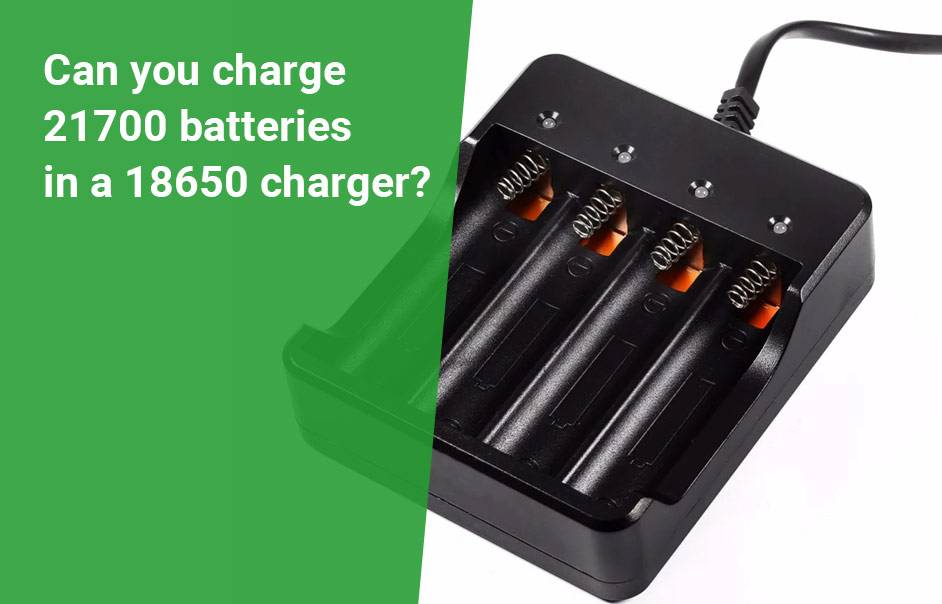
Utilizing an incompatible charger may lead to undercharging, overcharging, or overheating, risking damage to the battery and posing safety hazards. To ensure proper charging and mitigate potential risks, it is crucial to use a charger specifically designed for 21700 batteries.
FAQs
21700 vs 18650 batteries in cost
Choosing between 21700 and 18650 batteries involves considering factors like brand, capacity, and purchase location, impacting cost variations.
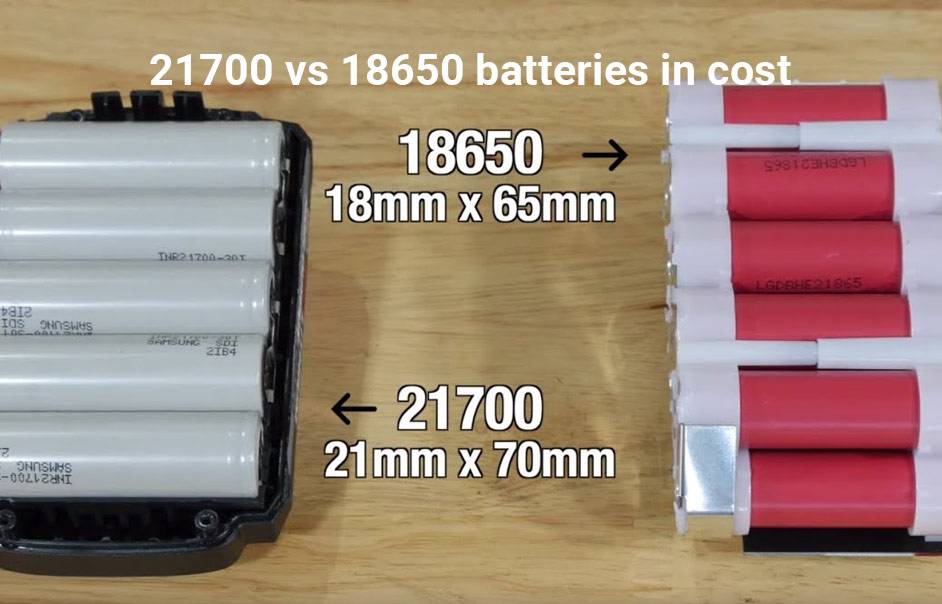
For instance, a Samsung INR21700-30T may cost around $8.99, while an LG MJ1 18650 could be around $4.49.
Redway offers competitive prices; check their 21700 battery wholesale price.
Generally, 21700 batteries are pricier due to higher capacity and longer device powering capabilities, compounded by their relative scarcity. When choosing a battery, assess cost and capacity for an optimal decision within budget constraints.
Does 21700 last longer than 18650?
Yes, 21700 cells generally last longer than 18650 cells due to their larger size and higher capacity, which often translates to more cycles and better performance. They also typically offer improved energy density and thermal management, contributing to a longer lifespan.
Who produces 21700 and 18650 cells?
Major manufacturers of 21700 and 18650 cells include Panasonic, LG Chem, Samsung SDI, and BYD. These companies supply cells for various applications, including electric vehicles, consumer electronics, and energy storage systems.
How to choose the correct lithium battery for your electric mobility?
Choose a lithium battery for electric mobility by considering the required voltage and capacity for your device, ensuring compatibility with your system. Evaluate factors like energy density, discharge rate, and cycle life. Check for reliable brands with good warranties and support.
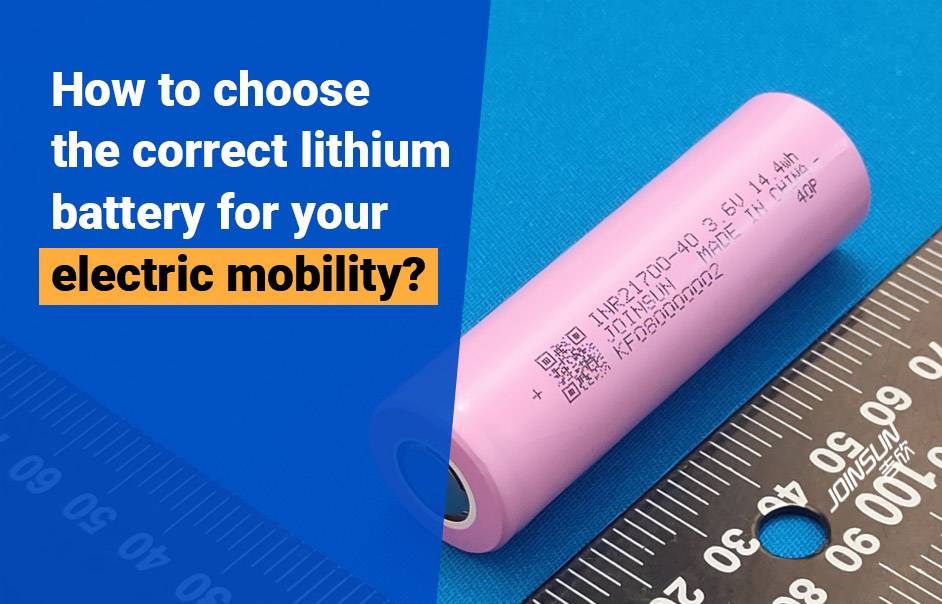
What are the differences between 18650 and 38120 cells?
The 18650 cell measures 18 mm in diameter and 65 mm in length, with a capacity of 2,500-3,500 mAh. The 38120 cell is larger at 38 mm x 120 mm, offering 6,000-10,000 mAh. The 38120 provides higher capacity and energy density, making it suitable for high-power applications.
What tools and resources are available for DIY battery projects?
DIY battery projects can use a Battery Management System (BMS), spot welders, soldering irons, voltage meters, and heat shrink tubing. Resources include online tutorials, forums, educational websites, and battery design software to guide assembly and ensure safety.
Will 21700 cells likely replace 18650 cells as the industry standard?
Yes, 21700 cells are expected to replace 18650 cells as the industry standard due to their higher capacity and energy density. They are increasingly used in advanced applications like electric vehicles and high-performance battery packs.
Are 21700 and 18650 cells the same?
No, 21700 and 18650 cells differ in size and performance. The 21700 cell is 21 mm x 70 mm with 3,000-5,000 mAh capacity, while the 18650 cell is 18 mm x 65 mm with 2,500-3,500 mAh. The 21700 offers higher capacity and efficiency.
What performance improvements does Tesla claim for the 4680 cell compared to the 21700 cell?
Tesla claims the 4680 cell offers improved energy density, increased range, and enhanced thermal performance compared to the 21700 cell. The 4680’s larger size allows for a higher energy capacity and better performance due to advancements in cell chemistry and design, which also contribute to reduced manufacturing costs.
What impact does the move to larger cells like 21700 have on the complexity and cost of the battery management system (BMS)?
The move to larger cells like the 21700 can simplify the battery management system (BMS) by reducing the total number of cells required in a pack. This potentially lowers BMS complexity and cost, as fewer cells and associated connections can reduce the overall monitoring and balancing requirements.
What are the pack level considerations when moving from 18650 to larger cell formats like 21700, 25700, or 30700?
When moving from 18650 to larger cell formats, considerations include changes in energy density, pack design, thermal management, and structural integrity. Larger cells can improve energy density but may require adjustments in cooling systems and pack layout to manage heat and ensure efficient battery pack performance.
How do the capacities of 20700, 21700, 22700, 25700, and 30700 cells compare to 18650 cells?
The capacities of larger cells typically exceed those of 18650 cells. For example, while 18650 cells usually have capacities around 2,500-3,500 mAh, cells like 21700 can range from 3,000-5,000 mAh, and even larger cells like 30700 can exceed 5,000 mAh, offering higher energy storage.
How does the periodic winding distance (dascs) in the jelly roll structure affect cell performance?
The periodic winding distance (dascs) in the jelly roll structure affects cell performance by influencing the battery’s internal resistance and heat dissipation. A well-designed winding distance can improve charge/discharge efficiency and thermal management, leading to better performance and longevity of the cell.
How are cylindrical Li-ion cells constructed, and what is the significance of the jelly roll format?
Cylindrical Li-ion cells are constructed by winding a combination of positive and negative electrodes separated by a separator into a cylindrical shape, known as the jelly roll format. This design allows for efficient use of space and materials, providing a compact and high-energy-density cell structure.
What are the intended applications for 26650 Li-ion cells?
The 26650 Li-ion cells are typically used in high-capacity applications where larger size and energy density are beneficial, such as in high-performance flashlights, electric vehicles, power tools, and other devices requiring extended run times and higher power outputs.
How do 16340 Li-ion cells compare to primary CR123A batteries in terms of size and voltage?
16340 Li-ion cells are rechargeable and slightly larger than CR123A batteries, with a nominal voltage of 3.7V compared to the 3V of CR123A batteries. The 16340 cells offer higher capacity and are reusable, while CR123A batteries are non-rechargeable but often used for their reliable power in various applications.
What are the characteristics and typical applications of 14500 Li-ion cells?
14500 Li-ion cells are similar in size to AA batteries but offer higher energy density with a nominal voltage of 3.7V. They are used in applications requiring compact, rechargeable power sources, such as in small electronics, portable devices, and as replacements for AA batteries in various gadgets.
Two Types of Battery Management Systems (BMS)
The two main types of BMS are passive and active. Passive BMS balances cells by dissipating excess energy as heat, while active BMS redistributes energy among cells to maintain balance, improving efficiency and performance.
How to Reduce 48 Volts to 24 Volts
To reduce 48 volts to 24 volts, use a DC-DC converter or buck converter designed for voltage step-down applications. These devices efficiently lower voltage while maintaining power stability.
Factors That Shorten Lithium Battery Life
Lithium battery life can be shortened by high temperatures, overcharging, deep discharging, and excessive current draw. Proper maintenance and adherence to recommended charge cycles help prolong their lifespan.
Using a 21700 Battery Instead of 18650 Cells
You can use a 21700 battery in place of 18650 cells if the device supports the larger size and capacity. Ensure compatibility with voltage, size, and current requirements of the device.
Can a 18650 Charger Charge 21700 Cells?
No, a standard 18650 charger typically cannot charge 21700 cells due to size differences. Use a charger specifically designed for 21700 batteries to ensure proper charging and safety.
Do 21700 Batteries Fit 18650 Devices?
No, 21700 batteries do not fit in 18650 devices because they are larger in diameter and length. Ensure device compatibility with battery size before use.
How to Get 5% Off at Battery Hookup
To get 5% off your entire order at Battery Hookup, use the promo code “5OFF” during checkout. Check their website for current discounts and codes.
How to Get a Discount on My Next Order at Battery Hookup
Sign up for the Battery Hookup newsletter or follow them on social media for exclusive discount codes and offers. Check their website or promotions page for current deals.















